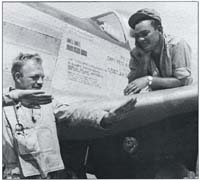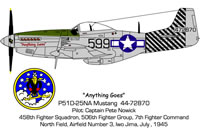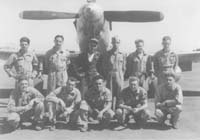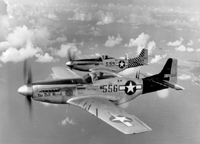|
Major Harrison E. Shipman was the units first CO. An early veteran who assisted in the training program was 1st Lt. Frank H. Mekus who had served a combat tour of duty with the 18th Fighter Group in the Southwest Pacific. (He left the squadron prior to overseas deployment.) Moving to the West Coast in February 1945, the ground echelon boarded transports and sailed for Hawaii. The air echelon arrived in Honolulu on 6 March 45 and departed with its P-51s aboard the escort carrier Kalinin Bay (read more as the Kalinin - saw a lot of action) . The air echelon arrived Guam (MAP) on 23 March and soon set up shop at West Field #4 on Tinian (MAP) . They began flying CAP missions on 27 March. The balance of the 458th, aboard transport Bloemfontein, had a slow unhappy trip that involved high seas and considerable sea sickness. The Bloemfontein also spent a week for an unscheduled stop in Honolulu (dry dock) to repair some storm caused hull damage (?) prior to it's 10 day layover at Eniwetok Atoll. A brief tour of the Island along with 15 cent Navy whiskey was a welcome diversion. It was not until April 20th that the ground echelon saw the Marianas, and just four days later they came within sight and scent of Iwo Jima. While the ground echelon set up camp on the inhospitable island, the air echelon languished in Tinian (MAP), held up from going to Iwo by a shortage of 110 gallon drop tanks. Not until May 11, 1945 did the Mustangs of the 458th fly into Iwo Jima (MAP). A few days later the squadron began flying defensive CAP. On May 18th the unit suffered its first fatality when F/O John Cream was killed in a plane crash. The first strike on Japanese territory was mounted on 22 May - a bombing mission against Chichi Jima by eleven 458th aircraft. The 458th participated in the Group's first VLR mission to Japan on 28 May 1945, a strafing attack on Kasumigaura Airdrome on Honshu. The 506th Group reported some 50 Japanese aircraft destroyed or damaged on the ground. And despite the long over-water trip, the 458th was enthused about results and the lack of any losses. The next VLR mission, on 1 June 1945, involved the 506th in one of the AAF's worst aerial disasters of World War II. Flying with the 21st and 15th Fighter Groups, all escorted by B-29 navigators, the formation encountered a towering weather front 250 miles north of Iwo, less than half way to Osaka ((MAP). Led by the B-29s the formation of 170 Mustangs attempted to penetrate the weather and encountered severe turbulence and loss of visibility. (this story in more detail - click here) The 458th's losses could have been greater, as 2nd Lt. Thomas F. Harrigan was seen to parachute from his disabled plane 200 miles from Iwo Jima. He was presumed lost as high seas frustrated rescue attempts over the next few days. But on June 3rd a Navy PBY saw the flash of a signal mirror and directed a destroyer to Harrigan's rescue. Thomas was later lost on a later mission over Tokyo. > |
 |
Capt. Pete Nowich shows Crew Chief, S/Sgt. John Stanfield how he bagged a pair of Japanese planes on a 10 June 1945 escort. (USAF) |
|
Weather frustrated several more VLR missions and it was not until June 10,1945 that the 458th extracted a price from the enemy while escorting B-29s to Tokyo. Engaged by some forty Japanese fighters, the 506th claimed ten kills without loss. Six of the victories were scored by 458th pilots, with Capt. Peter Nowick being credited with a double. On June 14th eight pilots of the 458th caught two small supply ships in the harbor at Chichi Jima and damaged both to an unknown extent. Successive VLR missions failed to find Japanese air forces until the airfield strafing mission of June 23, 1945. Attacking enemy airdromes in the Tokyo area the 457th and 462nd went down to strafe while the 458th provided top cover. It proved to be fertile hunting for the 458th led by Major Shipman. They were credited with ten kills, two probable's and one damaged in the air and one destroyed on the ground. Again, there were no losses for the squadron.
Increasingly the Japanese withdrew their aircraft from direct confrontation with the AAF and with masterful concealment and dispersion they made it harder to find their aircraft on the ground while extracting a heavy toll of attackers. On an airfield strafing mission of 8 July (the Narrative is below) the 506th lost four aircraft and two pilots all to flak. One of the lost pilots was Tom Harriqan who had narrowly missed death on June 1st . Six more P-51 s were damaged, 2nd Lt. Bill Lockney nursing his 458th aircraft back the 650 miles to Iwo Jima despite being wounded. The 458th scored two more aerial victories on this date. A final aerial encounter occurred on July 16, 1945 near Nagoya (MAP) when aggressive Japanese fighters jumped the 506th downing one Mustang and damaging another. The group claimed 10-1 -9 in this battle, the 458th scoring three kills. NARRATIVE: This was the dog-faced, shaggy-eared, murderous old grandpappy of them all. Flak came up by the carload, more than the squadron had ever seen before. It was the first visit paid Tokyo's Happy Valley, and the reception was eloquently unfriendly. Near landfall, six transports were called out at 4 o'clock low, but were not intercepted. The squadron flew at 15,000 , feet at landfall, and dived gradually as it cruised north to Mt. Fuji, and then turned northeast toward the western Suburbs of Tokyo. Airfields were scattered below like stamps in a catalogue; the. target could not be immediately found. The squadron circled, and circled, and finally, as heavy flak got heavier and more accurate, peeled off and attacked the nearest targets. In the melee of ack-ack and crossing strafing runs, three airfields were strafed. Of eight Jap operational a/c observed, one was damaged by Lt. Middaugh, Red 3. Hangars, radio stations, gun positions, and a few dummy e/a took most of the damage. |
The pilots of D Flight, 458 th Squadron. Top row (l. to r.): Quarterman Lee, F/O Harvey L. Bishop, Schlack, Phillips, Bodfish, Lambert. Bottom: Jensen, Kelsey, Johnson, McDowell, Lee Smith. (From Ralph Coltman) |
|
Withdrawal began on a heading of 265 degrees. Suddenly, over the heavily industrialized prefecture where B-29s had long made their runs, hell broke loose. Pilots swear that everything but the dunghills was thrown at them for 4 solid minutes. Planes were on the deck, indicating 350 mph, shooting at everything and anything, and the flak came up. It came up from 120mm. batteries, with instantaneous fuses that laid the bursts in the middle of the formations. The ugly black puffs of the heavy stuff were as thick as grass at 50 to 100 feet. Medium flak guns, twin naval guns, machine guns, 20mm. and 25mm. automatic weapons spun on their mounts, fired, tracked, and fired again. Tracers floated up thick as minnows in a school, but there were more of the dirty black bursts of heavy flak than anything else. Pilots shot up what they could to stop it, but it did not stop. Lt.Schlack was thrown on his back by the muzzle blast of a medium gun: Capt. Marcott disappeared in a barrage of heavy flak but came out unharmed. Planes rocked from continuous explosions above, below, to every side. Lt. Kuhn, Blue 4, was strafing a factory in the middle of the Valley when he took a hit in his left wing, in his ammunition bay., The .50 cal. he had left exploded. The wing stayed on, but its permanency was questionable. Kuhn started for the RP with Lts. Lee, Harrigan, and Starln. Then Harrigan was hit. His engine began to smoke as he lost coolant. He stayed with his plane as long as possible, in a desperate attempt to reach the sea, but the smoke got worse. Finally Harrigan slowed down and bailed out, at 4000 feet over a deserted valley, in the western foothills of the Tokyo plain. . His engine exploded soon after. It was over Happy Valley that Lt. Lockney won the first Purple Heart of the 506th Group. A 7.7mm. slug tore through the cockpit and would have wounded him seriously. It was deflected by a thick strand of radio wires. The wires shattered and the small pieces turned to shrapnel and drove into Lockney's right hip. F/O Craig was almost as lucky. On his first mission over the Empire, he caught an unpleasantly large piece of heavy flak in his right engine cowling. It cut the lead wires from his right magneto, but he returned to base. Flak was not the only danger over the Valley. Both strafing run and withdrawal were made into the west, into the sun. It was hard to see what lay ahead, and it was deathly impossible to get far enough above the deck to take a good look around. Power lines were the worst darker. When they could be seen, they were shot in two, When they couldn't be seen, they were dodged at the very last instant. Lts. Bodfish and Middaugh cut two lines. Capt. Marcott got another, and later, with his flight, put a good squirt into a string of railroad cars and a, large warehouse. Something was burning there when the flight left. Finally, as the squadron climbed into the Tokyo foothills and left the settled area behind, the flak ceased. Planes turned south, toward the RP. At landsend, things popped again. Capt. Marcott caught a fishing boat, just offshore; Lt. Peterson strafed a trawler full of ducking Nips. Marcott says that Peterson's fire lifted the trawler by her heels and shook her from stem to stern. During this playful mayhem, Lts. Starln, Lee, and Kuhn were 9000 feet above on their way to the RP, when 10 Jacks came out of the clouds, dead ahead.. Two flew high cover at 12,000 feet; the other eight were in flights of four, In mutual support at about 10,000 feet. Starin, Lee, and Kuhn attacked. .One of the high Jacks peeled off and came in behind Lt. Kuhn, shooting. Kuhn snapped under and dived for the deck firewalled. Tracers were breaking around him when Lt. Lee slid in behind the Jack, gave it a long and furious burst and flamed it. | ||
Lts. Coltman (599) and Commer (556) in the air over Iwo Jima. This was a publicity picture taken by a news photographer in the back seat of an AT-6, and the Mustangs are flying with flaps down to match the speed of the much slower Texan. Ralph Coltman is flying Pete Nowick’s Mustang because “Betty Ann” was not available. For some unknown reason, 556 was being repainted at the time (note the unfinished star on the left wing and the solid tail). Note also Iwo Jima behind the planes, and there are three more Mustangs in the picture, visible as dots in the distance.(From Ralph Coltman) |
|
Lt. Starin meanwhile closed in on the left hand flight of four and put a long burst into a straggling e/a,. The Jack took it, then, as pieces broke off his fuselage and smoke poured from his engine, he broke for the deck. The opposite flight of four turned into Starin, and put a hole in his vertical stabilizer before he broke down at full throttle and escaped. A few minutes later Maple flight began to get business. Several bailouts came in rapid succession, over the RP or near it. Most were from another Group; one was Lt. Mekus of the 506th, who had been flying with the 457th squadron. Mekus was rescued by the lifeguard submarine soon after he hit the water. Then a distress call came in from a pilot bailing out some 100 miles northeast, just offshore. The submarine could not attempt rescue because of mines and coastal batteries. Maple flight, 2 B-29's, and a dory-hung B-17 headed, for the position. Three motorboats were close to the reported position of the downed pilot, but turned back to shore as soon as the rescue planes appeared. Two rowboats remained some 3 miles offshore, and another lay a few miles farther out. Lt. Kelsey, Maple leader, took a squirt at the lone boat, for it was chasing something that could have been a man trying to swim to sea. The splashing was actually a school of fish, Maple flight flew over the other small craft, but did not strafe for fear the pilot had been rescued and was aboard. The area was searched thoroughly, but no trace of the pilot remained. Maple flight was finally ordered to return to base. It landed at 1950, after nine hours and fifty minutes-of flight. Shortly after the main body of P-5ls had left the RP; Capt. Carmody, Green leader, saw a 462nd, a/c' trailing coolant and smoke. He circled with the damaged P-51 until the engine caught fire and the plane dived toward the sea. The pilot Lt. Freeman, bailed out just as his a/c began to burn. Green flight circled him after, he hit the water, calling for help. A dumbo finally located Freeman, and Green flight returned to base, landing with fuel tanks full of anything but. DAMAGE TO THE ENEMY; During a low level strafing mission of 26 July, 458th pilot 2nd Lt. Edwin "Ted" Warfield III was hit by flak downed and rescued by a submarine off the coast of Honshu (MAP). (Read his rescue story where he was in the drink for 6 days awaiting rescue). As the aerial war wound to a vicious end in August, Japanese flak gunners extracted an ever increasing toll. On August 3,1945 Seventh Fighter Command attacked targets in the Tokyo area. Four P-51 s went down and nine more carried battle scars back to Iwo Jima. The 458th lost 2nd Lt. Paul I. Ewalt, killed in action, and the aircraft of Capt. Edward H. Mikes, Jr. was hit and he parachuted into outer Tokyo Bay. (Read his story where he was strafed by enemy fighters while awaiting rescue). This triggered a marvelous rescue effort that involved Mustangs, B-29s, a pair of Navy Privateer patrol bombers an Air Force B-17 Super Dumbo and finally the submarine, Aspro. The B-17 had dropped a motorized launch to Mikes, who was trying to put distance between himself and the Honshu shoreline. Enemy aircraft interfered, Mikes was strafed, the four-engine PB4Ys flew CAP and downed two of the Japanese planes and ultimately, after being twice bombed, Aspro came to the rescue. Mikes spent the balance of the war aboard the submarine. Four successive VLR missions gained the 458th no further contact with the enemy who had now pulled into his defense shell awaiting the inevitable invasion. But the atomic bombs propelled the Japanese into a surrender on August 14th. The 458th suffered no further losses in the campaign after 3 August. The 458th had downed 22 enemy planes in aerial combat (highest scoring squadron for the 506th Group), probably destroyed three and damaged two more. They had destroyed or damaged many more on the ground and claimed several ships damaged. As part of the 506th Group they were awarded the Distinguished Unit Citation. |
 458th Photo man Harold Eustis who took care of Gun Camera film and other photo assignments - in this photo you can see that there was very little vegetation on Iwo after all the bombing and fighting. |
||
Iwo Jima 26 August
You can zoom in and out and search & print the article
Major |
H. E. Shipman |
M/Sgt Charles E. Barr |
Capt. |
J. B. Baker |
T/Sgt. William V. Brown |
Capt. |
F. C. Carmody |
T/Sgt. Cletus 3. Bunker |
1st Lt |
Nolen C. Johnson, Jr. |
T/Sgt. Albert L. Thompson |
1st Lt |
Goldle Marcott |
T/Sg t. Amil V. Wittenberger |
let Lt |
E. H. Mikes, Jr. |
T/Sgt. John M. Rico |
1st Lt |
Richard W. Barnes |
S/Sgt. Clinton J. Delay |
1st Lt |
D. E. Harris |
S/Sgt. Carl A. Kill |
1st Lt |
Quarterman Lee |
S/Sgt. Charles G. Hunter |
1st Lt |
E. H. Connor III |
S/Sgt. John J. Kershaw |
1st Lt |
Evan S. Stuart |
S/Sgt. Oscar P. Larsen |
1st Lt |
Donald L. Richmond |
S/Sgt. Jack J. Lee |
1st Lt |
Vance A. Middaugh |
S/Sgt. Henry E. Kaher |
1st Lt |
Neil T. Smith |
S/Sgt. Kirby G. Page |
1st Lt |
John J. Gallagher |
S/Sgt. Francis R. Sundbergl |
1st Lt |
Vaugh E. Sowers |
S/Sgt. Harold B v P. Upshaw |
2d Lt. |
James E. Coleman |
S/Sgt. Paul Zivkovich |
2d Lt, |
Bennet C. Commer |
S/Sgt. Walter F. Zo.jonc |
2d Lt. |
Harold G. Davidson |
S/Sgt,.Morris H. Blalock |
2d Lt. |
Thomas F. Harrigan |
Sgt. Andrexv P. Finan, Jr. |
2d' Lt. |
Jack A. Kelsey |
Sgt-. Charles L. Hagerty |
2d Lt. |
Roy W. Kempert |
Sgt. Donald L. Good |
2d Lt. |
G. B. Lambert |
Sgt. William J. Eimpel |
2d Lt. |
Max E. Ruble |
Sgt. Ben Yanda |
2d Lt. |
Frank H. Wheeler |
Sgt. Harold. R. Beveridge |
2d Lt. |
Francis N. Hines |
Sgt. Peter P. Rainone |
2d Lt. |
Donald C. Ttfidner |
Cpl. Doyle G. Gardner |
| Cpl. Gordon J. Grams |
Arrival time: 12/22/2025 at: 3:31:43 PM
Home | Reunions | Contact Us | VLR Story | Mustangs of Iwo Jima | Combat Camera Footage | Battle of Iwo | 457th | Webmaster ©506thFighterGroup.org. All Rights Reserved. |





